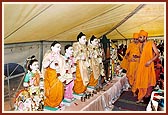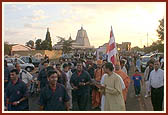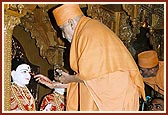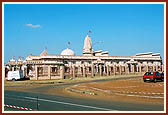Johannesburg witnessed
a weekend of joyous festivities when His Divine Holiness Pramukh Swami
Maharaj graced the city on 9 September 2004. Having completed a long
and rigorous 5-month spiritual tour of UK, USA and Canada, he arrived
in Johannesburg, South Africa at the start of his African tour.
The highlight of his trip
to Johannesburg was the opening of the first traditional style Mandir
and cultural complex in Lenasia, south of Johannesburg, on 10th, 11th,
12th September. This three day event was attended by an average of five
thousand people per day and included guests from as far as USA, UK,
India, Canada, and East Africa.
Highlights of Key
Events:
10th Sept: Vishvashanti
Mahayagna
 Swamishri
performed the yagna rituals and consecrated the murtis. About 350 people
participated in the yagna as part of the murti-pratishtha ceremony. Swamishri
performed the yagna rituals and consecrated the murtis. About 350 people
participated in the yagna as part of the murti-pratishtha ceremony.
10th Sept. Nagar Yatra
 The
mood then turned festive as a Nagar Yatra paraded through the streets
of Lenasia, from 3:00 pm to 6:30 pm, displaying ornately decorated floats
carrying the murtis to be installed in the mandir. The murtis of Shri
Akshar Purushottam Maharaj, Shri Radha-Krishna Dev, Shri Sita-Ram with
Hanuman, Shri Shiv-Parvati with Ganapatiji, and the Guru Parampara were
displayed on floats. BAPS sadhus sang kirtans as devotees in traditional
dress danced with joy and devotion. The parade route passed all the
main mandirs in Lenasia. The
mood then turned festive as a Nagar Yatra paraded through the streets
of Lenasia, from 3:00 pm to 6:30 pm, displaying ornately decorated floats
carrying the murtis to be installed in the mandir. The murtis of Shri
Akshar Purushottam Maharaj, Shri Radha-Krishna Dev, Shri Sita-Ram with
Hanuman, Shri Shiv-Parvati with Ganapatiji, and the Guru Parampara were
displayed on floats. BAPS sadhus sang kirtans as devotees in traditional
dress danced with joy and devotion. The parade route passed all the
main mandirs in Lenasia.
Thousands of people, representing
Hindu organizations around the country participated in this parade with
traditional dances and singing.
11th Sept. Murti-Pratishtha
 On
this auspicious day, His Divine Holiness Pramukh Swami Maharaj inaugurated
the BAPS Shri Swaminarayan Mandir, first traditional style Hindu mandir
in Lenasia, Johannesburg. Swamishri arrived after his morning puja and
officially opened the mandir. He then made his way inside to perform
the murti-prathistha ceremony in accordance with Vedic rituals. Swamishri
invoked the spirit of God into the murtis of Bhagwan Swaminarayan, Aksharbrahma
Gunatitanand Swami, Shri Radha-Krishna Dev, the Guru Parampara, Shri
Sita-Ram and Hanumanji and Shri Shiv-Parvati and Ganapatiji. He then
performed the arti and darshan and blessed the participants. On
this auspicious day, His Divine Holiness Pramukh Swami Maharaj inaugurated
the BAPS Shri Swaminarayan Mandir, first traditional style Hindu mandir
in Lenasia, Johannesburg. Swamishri arrived after his morning puja and
officially opened the mandir. He then made his way inside to perform
the murti-prathistha ceremony in accordance with Vedic rituals. Swamishri
invoked the spirit of God into the murtis of Bhagwan Swaminarayan, Aksharbrahma
Gunatitanand Swami, Shri Radha-Krishna Dev, the Guru Parampara, Shri
Sita-Ram and Hanumanji and Shri Shiv-Parvati and Ganapatiji. He then
performed the arti and darshan and blessed the participants.
After the ceremony Swamishri made his way
to the main entrance of the mandir complex where he released red and
white peace balloons.
The landscape of Lenasia was changed forever
on this day.
12th Sept. 10:30-12:30:
Sanman Sabha
During this assembly, members of the community who have made great contributions
to social service and advancement of South African society were honoured.
The Guest of Honour was Mr Pravin Gordon, Commissioner of South African
Revenue Services. In his speech he appealed to the Indian community
to unite in building a better South Africa for all and that the Mandir
be the center for uniting people and uplifting society.
Other guests, namely, Laloo
“Isu” Chiba, Reggie Vandeyar, Mickey Padiachee, Ismail Vadi,
Prema Naidoo and Ebrahim Ismail Ebrahim were honoured for their contributions
to social upliftment in our society, each in their unique ways.
Facts and Figures about the BAPS Shri Swaminarayan Mandirs Lenasia
 The
Mandir is located on 1100 square metre of prime land at the corner of
Hydrangea Avenue and Bengal Street, Lenasia Ext 11. The
Mandir is located on 1100 square metre of prime land at the corner of
Hydrangea Avenue and Bengal Street, Lenasia Ext 11.
The plans for the Mandir were drawn up
in India by the architects of BAPS’s Planning Cell and finalised
in South Africa.
The construction of the Mandir
project began in April 2003 and it was consecrated by Pramukh Swami
Maharaj on 11 September 2004.
Some of the components were imported from
India to preserve the traditional art and architecture of Mandir construction.
The mandir has one Shikhar, one Gummat, one Samran, twelve Gumtis, thirty-six
Gavakshas (window frames) and hundreds of Kangras.
Nine hand carved doors made of solid Burmese
Teak together with a large hand carved Sihasan (main altar) made of
solid Cherry Wood has also been specially made in India.
All ten murtis to be installed in the Mandir are made of marble. Of
course, no Hindu Mandir is complete without the golden Kalash.
Modern technology has been
used to make all the intricate patterns on pillars, columns; beams and
torans.
|





